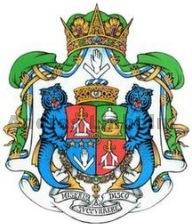Tierced per pale: Vert, a crescent Argent with a flame Or issuant from its interior, enclosing a five-rayed star of the second (the arms of devotion, borne also for the religious authority of the sultans as well as for the royal house of Kiram); Gules, a gateway represented as two pillars Argent set on a doorstep of the same and above, by Zulfiqar also Argent, hilt and pommel in chief Or and blades resting on the pillars (“the Gateway to Mecca”, for the Royal Sultanate of Sulu); and Vert, a Borneo roofed boat Or ensigned by a fringed umbrella Argent (for the part of Royal Sultanate of Sulu known as the territory of North Borneo).
The shield is ensigned with the songkok [ceremonial cap] of the sultan, above which on a wreath Argent and Azure for the crest is set Zulfiqar Argent, its hilt and pommel Or turned upwards, its blades enclosing a pearl Argent.
For supporters are set two sea-tigers embowed and guardant Or, langued Gules and striped Sable; that to the dexter holding in his sinister paw a keris Argent hilted Or, and that to the sinister, in his dexter paw, a spear Argent hafted Or.
The shield is surrounded with the collar of the royal order of the pearl.
The Royal robe (which is Vert, bordered twice Azure and Argent with double flames Or set on the borders’ lengthwise partition, lined Argent, corded and tasseled Or) is ensigned with the Royal crown of Sulu. Above and behind the crown, the State Gonfanon is issuant, which is represented as a traditional sail-flag [sambulayan] Vert, bearing a chief enhanced per fess Azure and Argent, and two flames Or, each charged with a smaller flame per fess Azure and Argent, issuant over the stripe.
The sambulayan is adorned with pleated edges Or instead of a fringe, and surmounted with a small standard Vert ensigned with the inflamed crescent and star emblem Or; at the sides, the sambulayan’s horizontal staff is pommetty Or and corded of the same, with small triangular flags Gules sans nombre adorning the cords.
For the motto, “TUBUH SUG SARAYAW RAYAW” is written in characters Sable on a ribbon Or, which ribbon is placed below the shield; and for the slogan, “LABI MARAYAW” is written in characters Argent on a ribbon Gules, which ribbon is placed above the Gonfanon.






